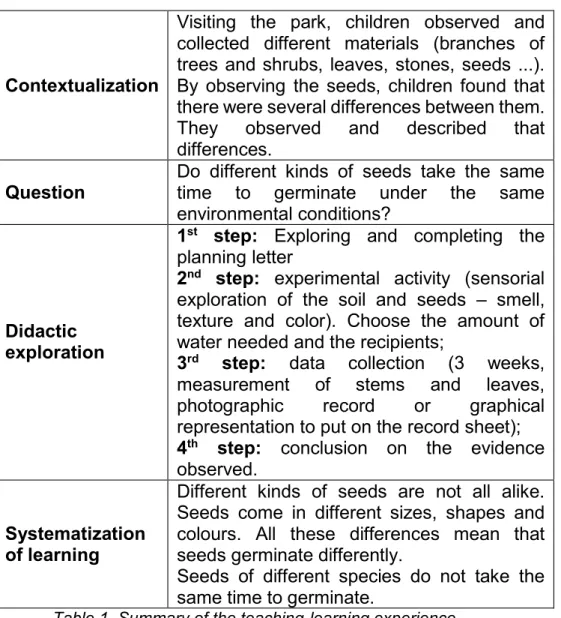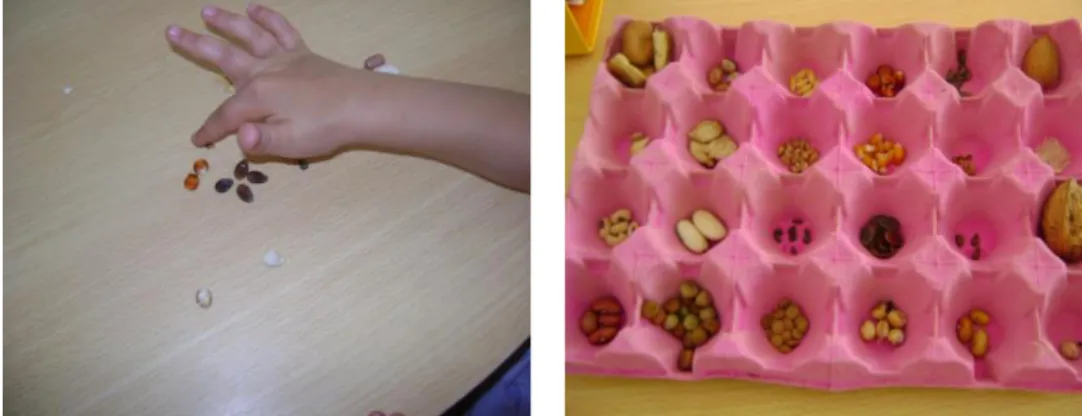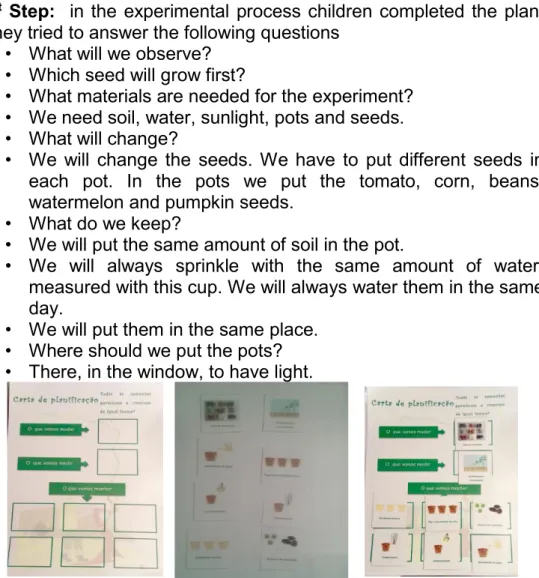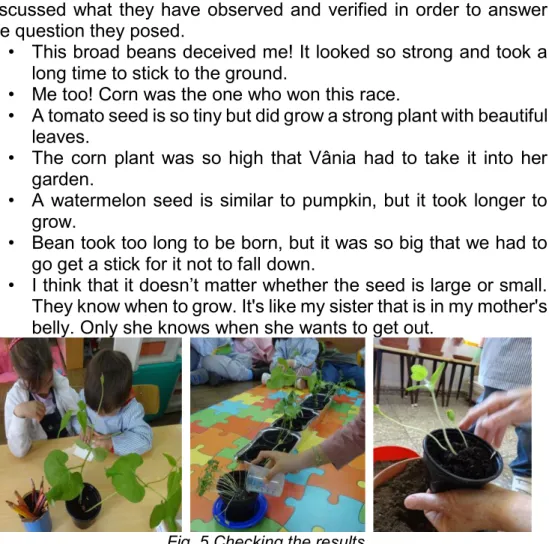A HANDBOOK ON
EXPERIENTIAL EDUCATION.
PEDAGOGICAL GUIDELINES FOR TEACHERS AND PARENTS
Editors:
Gianina-Ana MASSARI
Florentina-Manuela MIRON
Violeta KAMANTAUSKIENE
Zeynep ALAT
Cristina MESQUITA
Marina TZAKOSTA
Jan Karel VERHEIJ
Tija ZIRINA
EXPEDUCOM
EDITURA UNIVERSITĂȚII ”ALEXANDRU IOAN CUZA” DIN IAȘI
Erasmus+ Project:
Experiential Education Competence
(teaching children aged 3-12) – EXPEDUCOM
The grant reference number:
2
Editors:
Gianina-Ana MASSARI
Florentina-Manuela MIRON
Violeta KAMANTAUSKIENE
Zeynep ALAT
Cristina MESQUITA
Marina TZAKOSTA
Jan Karel VERHEIJ
Tija ZIRINAA
A HANDBOOK ON
EXPERIENTIAL EDUCATION.
PEDAGOGICAL GUIDELINES FOR TEACHERS
AND PARENTS
2016
3
Gianina-Ana MASSARI
Florentina-Manuela MIRON
Violeta KAMANTAUSKIENE
Zeynep ALAT
Cristina MESQUITA
Marina TZAKOSTA
Jan Karel VERHEIJ
Tija ZIRINA
Erasmus+
Project Title:
Experiential Education Competence (teaching children
aged 3-12) EXPEDUCOM
The grant reference number: 2014-1-LT01-KA200-000368
Descrierea CIP a Bibliotecii Naționale a României:
MASSARI, Gianina-Ana, MIRON, Florentina-Manuela,
Violeta KAMANTAUSKIENE
A Handbook on Experiential Education. Pedagogical
Guidelines for Teachers and Parents / Gianina-Ana
Massari; -
Iași: Editura Universității Alexandru Ioan
Cuza din Iași, 2016
4
HANDBOOK CONTENTS
Foreword
(Violeta Kamantauskiene)
7PART A.
GENERAL FRAMEWORK ON EXPERIENTIAL LEARNING
9
CHAPTER 1. WHAT IS EXPERIENTIAL LEARNING?
(Gianina-Ana Massari, Manuela-Florentina Miron) …….……
10
1.1. Concept ………. 12
1.2. Characteristics of experiential based learning………. 14
1.3. The principals of experiential orientation……….. 17
1.4. Experiential based learning stages……… 18
1.5. Teacher roles………..……... 19
1.6. Children roles ……… 20
1.7. Integration of experiential learning in teaching …….… 20
CHAPTER 2. OVERVIEW OF CONCEPTUAL FOUNDATIONS ON THE EXPERIENTIAL BASED LEARNING (Gianina-Ana Massari, Cristina Mesquita, Rosa Novo)……….……….. 22 2.1. Instructional models for the experiential learning theory (Gianina-Ana Massari) ……….……… 22 2.2. Dewey’s foundations for the Experiential Based Learning (Cristina Mesquita) ………. 26
2.3. Implications of Vygotsky’s ideas on learning process (Gianina-Ana Massari)………..…………. 30 2.4. Bruner’s conceptual contribution to the experiential based learning (Cristina Mesquita) ………….………... 32 2.5. The Jean Piaget’s perspective (Rosa Novo) ………….… 35
2.6. Kolb's experiential learning theory (Gianina-Ana Massari)……..………. 37
CHAPTER 3. CITIZENSHIP AND 21ST CENTURY EDUCATION (Jan Karel Verheij, Frank van Herwaarden, Gerben de Vries)………... 39 3.1. An overview of 21st century skills education (Jan Karel Verheij, Frank van Herwaarden)... 39 3.2. What kind of citizens are needed in the Netherlands in the 21st century? (Gerben de Vries)... 47 CHAPTER 4. DIFFERENT APPROACHES OF EXPERIENTIAL EDUCATION (Marina Tzakosta, Cristina Mesquita, Luis Castanheira, Rosa Novo) ……….….. 62 4.1. Reggio Emilia Approach (Marina Tzakosta) ………. 62
5
4.2. High Scope Approach (Cristina Mesquita) ……….... 65
4.3. Pedagogy in Participation or MEM (Luis Castanheira, Rosa Novo)………..…..………
70
PART B. RESEARCH REPORT SURVEY……… 73
Chapter 5. INTERNATIONAL RESEARCH REPORT ON EXPERIENTIAL LEARNING APPROACHES ……….
74
PART C.
EXAMPLES OF EXPERIENTIAL BASED LEARNING DEVELOPED IN DIFFERENT COUNTRIES ………
112
CHAPTER 6. CASE STUDIES ON EXPERIENTIAL
EDUCATION IN KINDERGARDEN ………..……
113
6.1. Greece: Teaching Mathematics In An Experiential Way… 114
6.2. Latvia: Three Little Piglets And A Wolf………. 120
6.3. Lithuania: Experiential Learning Project “Friendly
Vegetables”……….……….. 123 6.4. Lithuania: Experiential Learning Project “I Care About
Our Nature”……….. 127 6.5. Lithuania: The Smart Games………. 132
6.6. Lithuania: Experiential Learning Activity “Math
Outdoor”……… 136 6.7. The Netherlands: Enrich Outdoor Education By
ICT……….… 141
6.8. Portugal:Winning The Race……….. 146
6.9. Portugal:Germinating Seeds………. 150
6.10. Romania: Experiential learning project in early childhood education: Floating Raisins ….……….
156
6.11. Romania: Geometrical Shapes Through Outdoor Learning...
164
6.12. Romania: Experiential learning project in kindergarden:Invisible Ink...
168
6.13. Turkey: Healthy Life Style ……… 171
CHAPTER 7. CASE STUDIES ON EXPERIENTIAL
EDUCATION IN PRIMARY SCHOOL ………..…
175
7.1. Greece:How the “refugee issue” helps children become
citizens of the world………..…… 176 7.2. Latvia: Three little piglets and how they built their
houses………. 182 7.3. Lithuania: A beautiful world. Noun plurals………. 186
7.4. Lithuania: Happy geometrical shapes... 192
Perspective of the Modern School Movement
6
7.5. The Netherlands: From people planet prosperity towards
involved citizenship……… 197 7.6. Portugal: Researching about space, astronauts, planets
and stars……….…… 201 7.7. Romania Experiential Learning Project In Primary
School: Let’s Count Outdoor!...
205
7.8. Romania: Architectural and Environmental Issues As
Experiential Learning Activity……… 209
7.9. Romania: Experiential Learning Project In Primary School: Bean's Diary……….....
213
7.10. Romania: Experiential Learning Project In Primary School: Build A Parachute!......
217
7.11. Turkey: Wind power……….. 221
PART D.
Chapter 8. INSTEAD OF CONCLUSIONS (Gianina-Ana Massari)………..….
226
150
Case study no. 9
on experiential education in kindergarden
6.9. GERMINATING SEEDS
Alice ALVES,
Schools of Mirandela, Portugal
Cristina MESQUITA,
Polytechnic
Institute of Bragança, Portugal
Maria José RODRIGUES,
Schools of Mirandela, Portugal
Context and participants
Pedagogical approaches
Science activities provide opportunities for cooperation, negotiation, rules following, rights and duties understanding, group involvement learning, and education for citizenship. These are essential skills for critical thinking and to create, conscious, participatory and supportive autonomous citizens. The learning experiences developed in kindergarten constitute an excellent way to use procedures and skills such as: observing, recording, measuring, comparing, counting, describing, and interpreting. These skills are not exclusive of science; these are capabilities that enhance a holistic worldview. In this study we describe an experimental activity, in the scope of botany, associated with the conditions that allow seeds to grow. This subject is present in the everyday life of children and the discussion of these issues enables them to understand the world.
Participants
Kindergarten
teacher
24 children of
five years old
Kindergarten
151
Teaching and learning experience (description)
The described learning experience is part of a broader project, developed over several months, called "Everything is different!”
Contextualization
During a visit to the park, the children gathered different materials (branches of trees and shrubs, leaves, stones, seeds ...). By observing the collected seeds, children found that there were several differences between them. To respond to the questioning of children, the teacher suggested to explore some activities that allow them to:
- Realize the diversity of seeds concerning its features; - Verify that the germination of a seed originates a new plant; - Recognize that even under the same environmental conditions, germination time is not the same for different kinds of seeds;
The experimental procedure is synthetized in table 1.
Contextualization
Visiting the park, children observed and collected different materials (branches of trees and shrubs, leaves, stones, seeds ...). By observing the seeds, children found that there were several differences between them. They observed and described that differences.
Question
Do different kinds of seeds take the same time to germinate under the same environmental conditions?
Didactic exploration
1st step: Exploring and completing the planning letter
2nd step: experimental activity (sensorial exploration of the soil and seeds – smell, texture and color). Choose the amount of water needed and the recipients;
3rd step: data collection (3 weeks, measurement of stems and leaves, photographic record or graphical representation to put on the record sheet); 4th step: conclusion on the evidence observed.
Systematization of learning
Different kinds of seeds are not all alike. Seeds come in different sizes, shapes and colours. All these differences mean that seeds germinate differently.
Seeds of different species do not take the same time to germinate.
152
With the seeds they found, and with others that the kindergarten teacher took to the classroom (tomato, pumpkin, beans, broad bean, peas, watermelon, nuts, almonds, chickpeas, lettuce, watercress), children classified, compared and weighted the seeds, discovering that they were different, even within the same species. Children found that some seeds were bigger than others, have different color and different textures.
Fig. 1 Sorting seeds according to their features
During the exploration the teacher asked about what would happen if those seeds were swon:
John: Plants will grow!
Kindergarten teacher: What kind of plants?
Rita: Different plants.
Because of that, the kindergarten teacher suggested that they should investigate on the internet and in books the plants corresponding to each seed.
Fig. 2 Research for corresponding plants
Research question
153
• Yes. If we sow all today, all of the plants will appear at the same time.
• No! This one will appear first (referring to the bigger bean). It is bigger than the others and it has the strength to pierce the ground.
• The first to grow will be the one that will get the root first. It will then start to open the leaves.
• My mother puts her plants in the sun to grow. She told me that if the plants have a lot of sun, they grow healthy.
• Considering the children's responses the kindergarten asked? • What do you think about doing an experience with different
seeds to see what happens? • All the children agree with that.
Planification of the experimental work
1st Step: in the experimental process children completed the plan. They tried to answer the following questions
• What will we observe? • Which seed will grow first?
• What materials are needed for the experiment? • We need soil, water, sunlight, pots and seeds. • What will change?
• We will change the seeds. We have to put different seeds in each pot. In the pots we put the tomato, corn, beans, watermelon and pumpkin seeds.
• What do we keep?
• We will put the same amount of soil in the pot.
• We will always sprinkle with the same amount of water, measured with this cup. We will always water them in the same day.
• We will put them in the same place. • Where should we put the pots? • There, in the window, to have light.
154
Experimental Work
3rd Step: The children put the soil in the pots, exploring its smell, texture an color. Then they labeled each pot with the picture of the corresponding seed. They put the seeds into the soil and watered them with the same quantity of water. They registered that in the grid. During three weeks, they continued the observations and took notes and pictures about the growing process of the seeds.
Fig. 4 Experimental Work
Main Finding or discussion
4th Step: In a large group the children and the kindergarten teacher discussed what they have observed and verified in order to answer the question they posed.
• This broad beans deceived me! It looked so strong and took a long time to stick to the ground.
• Me too! Corn was the one who won this race.
• A tomato seed is so tiny but did grow a strong plant with beautiful leaves.
• The corn plant was so high that Vânia had to take it into her garden.
• A watermelon seed is similar to pumpkin, but it took longer to grow.
• Bean took too long to be born, but it was so big that we had to go get a stick for it not to fall down.
• I think that it doesn’t matter whether the seed is large or small. They know when to grow. It's like my sister that is in my mother's belly. Only she knows when she wants to get out.
155
5th Step: The activity ends with the systematization of discoveries, where children are encouraged to express their conclusions and the teacher translates with appropriated language the results.
Children found that there is a wide variety of seeds. That the seeds do not take the same time to germinate, noting that the first seed to germinate was corn and the last pumpkin. They also found that the plant had different roots. The plant that grew the most was beans. Thus they realized that seed size does not determine the size of the plant and the seeds germinate and grow in different ways.
Using in other contexts and age groups
Although the process described in this paper has been developed under the pre-school education, transferability is possible for other levels of education. The procedures developed in the learning experience that include formulating problems, observing, planning, experimenting and discussing the findings, should be encouraged at all levels of education.
The teacher's mediating role and the children’s center action are aspects that must be considered in the pedagogical interaction in schools.
In this regard, we believe that, with the appropriate adjustment of languages and considering the complexity of the issues and themes, this activity can be developed in different educational environments and age groups.
References
x Martins, I., Veiga, M. L., Teixeira, F., Tenreiro-Vieira, C., Vieira, R. M., Rodrigues, A. V., Couceiro, F. e Pereira S. (2009). Despertar para a
ciência – actividades dos 3 aos 6. Lisboa: Ministério da Educação,
Direcção-Geral de Inovação e Desenvolvimento Curricular.
x NRC. (1996). National science education standards. Washington, DC: National Academy Press.
x Martins, I., Veiga, M. L., Teixeira, F., Tenreiro-Vieira, C., Vieira, R. M., Rodrigues, A. V. e Couceiro, F. (2006). Educação em Ciências e Ensino



